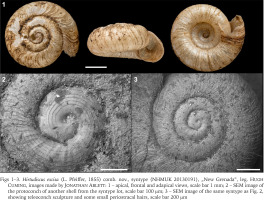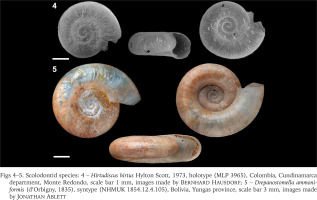INTRODUCTION
The genus Hirtudiscus was introduced by Hylton Scott (1973) for a peculiar micro gastropod from Colombia: Hirtudiscus hirtus Hylton Scott, 1973. After the genus had been described, it was further discussed in three papers, two of which sought to clarify its higher taxonomy and describe new species (Hausdorf 2003, Hausdorf & Medina Bermudéz 2006, Wendebourg & Hausdorf 2019). These publications make Hirtudiscus one of the better known, more properly described genera of Scolodontidae, along with the recently redescribed scolodontids Polygyratia Gray, 1847, Ridleyconcha Christensen, 2020, Scolodonta Doering, 1875 and Zilchistrophia Weyrauch, 1960 (Hausdorf 2006, Páll-Gergely & Asami 2014, Christensen 2020, Salvador & Cavallari 2020, Salvador 2021). However, most other genera are still poorly defined and often confused with each other.
To solve this issue a paper redescribing all scolodontid genera is in preparation (Roosen & Breure in prep.). During the preparation of this manuscript, the syntypes of Helix excisa L. Pfeiffer, 1855, which reside in the collection of the Natural History Museum of London (NHMUK), were also studied, because Helix excisa was used by Baker (1925a) to redefine the genus Drepanostomella Bourguignat, 1890. Baker’s description influenced later interpretations of Drepanostomella, like the interpretation in Ramírez (1993) and the comparison of Drepanostomella to Hirtudiscus in Hausdorf (2003).
Further examination of these syntypes, however, revealed that H. excisa shows shell characteristics of a Hirtudiscus species rather than those of true Drepanostomella as discussed by Cuezzo & Miranda (2009). Because of the important role this species has in several prominent papers on Scolodontidae, it is essential to rectify this taxonomic error before untangling all scolodontid genera in a subsequent paper.
Therefore, in this paper Helix excisa (L. Pfeiffer, 1855) is redescribed and detailed Scanning Electron Microscope (SEM) images of the syntypes are published for the first time. Based on characteristics revealed by these SEM images, it is moved to Hirtudiscus and the implications of this taxonomic decision are discussed.
MATERIAL AND METHODS
The syntypes of Helix excisa L. Pfeiffer, 1855 were examined under a Scanning Electron Microscope (SEM). These images were compared to the pictures and descriptions of Hirtudiscus Hylton Scott, 1973 in Hausdorf (2003) and Hausdorf & Medina Bermudéz (2006) and Drepanostomella Bourguignat, 1890 in Cuezzo & Miranda (2009). In addition, detailed images of the type species of both genera were requested and are published in this paper to enable easy comparison.
SYSTEMATIC PART
Family: Scolodontidae Baker, 1925b
Genus: Hirtudiscus Hylton Scott, 1973
Type species: Hirtudiscus hirtus Hylton Scott, 1973, by original designation
Diagnosis. The body and anatomy were thoroughly described by Hausdorf (2003). The shell is characterised by the presence of spiral sculpture on the protoconch, thin, waved axial ribs on the teleoconch and its periostracal hairs, combined with the generally discoid to sub-discoid outline of the shell, drop shaped to trapezoid aperture and incision near the suture.
Remarks. Several papers have served to define the genus (Hylton Scott1973, Hausdorf2003, Hausdorf & Medina Bermudéz2006). The diagnosis above is based on these publications.
Although the spiral sculpture on the protoconch is more typical for genera currently included in the Charopidae or Cystopeltidae, Hausdorf (2003) placed Hirtudiscus in the Scolodontidae based on anatomical characteristics. This placement is followed herein.
Hirtudiscus excisa (L. Pfeiffer, 1855) comb. nov.
Figs 1–3
Hirtudiscus excisa (L. Pfeiffer, 1855) comb. nov., syntype (NHMUK 20130191), „New Grenada”, leg. Hugh Cuming, images made by Jonathan Ablett: 1 – apical, frontal and adapical views, scale bar 1 mm; 2 – SEM image of the protoconch of another shell from the syntype lot, scale bar 100 µm; 3 – SEM image of the same syntype as Fig. 2, showing teleoconch sculpture and some small periostracal hairs, scale bar 200 µm

Helix excisa Pfeiffer – Reeve 1854: pl. CLXXXII, fig. 1260.
Helix excisaPfeiffer1855: p. 54.
Patulastra excisa (Pfeiffer, 1855) – Pfeiffer & Clessin 1881: p. 89.
Drepanostomella excisa (Pfeiffer, 1855) – Baker 1925a: pp. 24–25, pl. 8, figs 36–37.
Happia excisa (Pfeiffer, 1855) – Richardson 1989: p. 119.
Drepanostomella excisa (Pfeiffer, 1855) – Ramírez 1993: p. 22.
Drepanostomella excisa (Pfeiffer, 1855) – Breure et al. 2022: p. 103, fig. 127.
The specimens described or figured in this paper are present in the collection of the Natural History Museum of London, London, United Kingdom (NHMUK) and Museo de La Plata, La Plata, Argentina (MLP).
Studied material. NHMUK 20130191 (Syntypes, four dry shells) “New Granada”, leg. Hugh Cuming.
Type locality. “Santa Ana, New Granada” (Pfeiffer 1855).
Redescription. Shell nearly discoid; spire slightly elevated; with 3.75 whorls; protoconch 1.5 whorls, with distinct spiral striae; teleoconch with dense growth-striae carrying damaged periostracal hairs of up to 0.05 mm; body whorl rounded; aperture narrow near the suture, widening near the base (saccate); peristome sharp, neither expanded nor thickened; with an incision in the parietal angle of the aperture near the suture; suture deeply impressed; umbilicus wide, occupying about 40% of shell width.
Dimensions. Diameter major 3.9 mm.
Cross-diagnosis. Even though all six currently known Hirtudiscus species were described from Colombia and introduced to science without comparing them to H. excisa comb. nov., none of them appear to be synonyms of this species. The only other species with an elevated spire are H. boyacensis Hausdorf, 2003 and H. curei Hausdorf, 2003. Hirtudiscus excisa comb. nov. differs from these species mainly by its stronger spiral sculpture on the protoconch and its less circular aperture. That said, as the protoconch sculpture is a rather variable feature (see Hausdorf 2003), synonymy with H. boyacensis cannot be excluded.
Hirtudiscus hirtus Hylton Scott, 1973 (Fig. 4; Hausdorf 2003) on the other hand, is a species that differs a lot from H. excisa comb. nov. The shell of H. hirtus is nearly discoid and the axial ribs are much less prominent than in H. excisa comb. nov. Nevertheless, the spiral sculpture on the protoconch, presence of (vestiges of) periostracal hairs and the incision at the parietal angle of the aperture includes both species in the same genus.
Figs 4–5
Scolodontid species: 4 – Hirtudiscus hirtus Hylton Scott, 1973, holotype (MLP 3965), Colombia, Cundinamarca department, Monte Redondo, scale bar 1 mm, images made by Bernhard Hausdorf; 5 – Drepanostomella ammoniformis (d’Orbigny, 1835), syntype (NHMUK 1854.12.4.105), Bolivia, Yungas province, scale bar 3 mm, images made by Jonathan Ablett

Drepanostomella ammoniformis (d’Orbigny, 1835), the type species of Drepanostomella (Bourguignat 1890: fig. 5), is much larger, only has growth lines on early teleoconch whorls and minute spiral striae on younger whorls. The axial ribs seen on the teleoconch of Hirtudiscus are absent in Drepanostomella. Moreover, the peculiar way in which younger whorls cover older parts of the shell in Drepanostomella causes the shells to have a somewhat flattened outline in apical view whereas all Hirtudiscus species are subcircular as seen from above. Last, the whorl diameter increases faster.
Distribution. Colombia: Marmato (ANSP 23774, FMNH 78864). Other records are doubtful. Because many locations in former New Granada are named Santa Ana, the type locality cannot be traced.
Remarks. Ramírez (1993) identified several lots in the ANSP and FMNH collection as H. excisa comb. nov. ANSP 23774 and FMNH 78864 are still listed as H. excisa comb. nov. in the collection database of their institute (as Drepanostomella excisa or Happia excisa). The identification of these shells is also corroborated by Baker (1925a). The other records are doubtful as ANSP 105208 was identified by Baker (1925a) as a juvenile specimen of an unknown species of Radiodiscus which is “in too poor condition for description” and ANSP 322270 is currently listed in the ANSP database as an unidentified Drepanostomella species. The record from Ecuador presented by Breure et al. (2022) was also based on ANSP 322270. For the current paper, the ANSP and FMNH specimens were not studied.
Hitherto H. excisa comb. nov. has been most often included in Drepanostomella, which is much larger, does not have spiral sculpture on the protoconch, has no hairs on the periostracum and has much less prominent growth striae (Fig. 5; Cuezzo & Miranda 2009).
DISCUSSION and CONCLUSION
Thus, as demonstrated above, Helix excisa L. Pfeiffer, 1855 is a member of the genus Hirtudiscus Hylton Scott, 1973. This means that the description of Drepanostomella Bourguignat, 1890 s. str. in Baker (1925a), based on Hirtudiscus excisa comb. nov., should be interpreted as the first detailed account of a species of Hirtudiscus. It is also the first proof that a Hirtudiscus species was mixed-in with the material Ramírez (1993) used to define Drepanostomella.
The description of Baker (1925a) also influenced more recent literature. For instance, Hirtudiscus excisa comb. nov. was included in Drepanostomella recently by Breure et al. (2022). Moreover, in Hausdorf (2003) Hirtudiscus was compared to Drepanostomella in the discussion. This discussion was clearly influenced by Baker (1925a), as the paper was cited several times and shell surface structures typical for Hirtudiscus are attributed to Drepanostomella as well.
To make matters more complicated, characters of Helix ammonoceras L. Pfeiffer, 1855 were also used by Baker (1925a), Ramirez (1993) and Hausdorf (2003) to define Drepanostomella, while this species is the type species of Happia Bourguignat, 1890 (MolluscaBase 2021). This possibly has implications for the higher taxonomy of Drepanostomella, as many species are currently included in Happia and the base of this error predates the replacement of Ammonoceras L. Pfeiffer, 1855 (not Lamarck, 1822) by Happia in Bourguignat (1890). This issue will be addressed thoroughly in a forthcoming paper on all scolodontid genera (Roosen & Breure in prep.).
That said, for now Cuezzo & Miranda (2009) and the current paper can be used to reliably identify a species as Drepanostomella s. str., until the redescription of all type species and genera of Scolodontidae is available (Roosen & Breure in prep.). This paper is a solid first step towards clarification of the genera of Scolodontidae that have not been redescribed yet.

